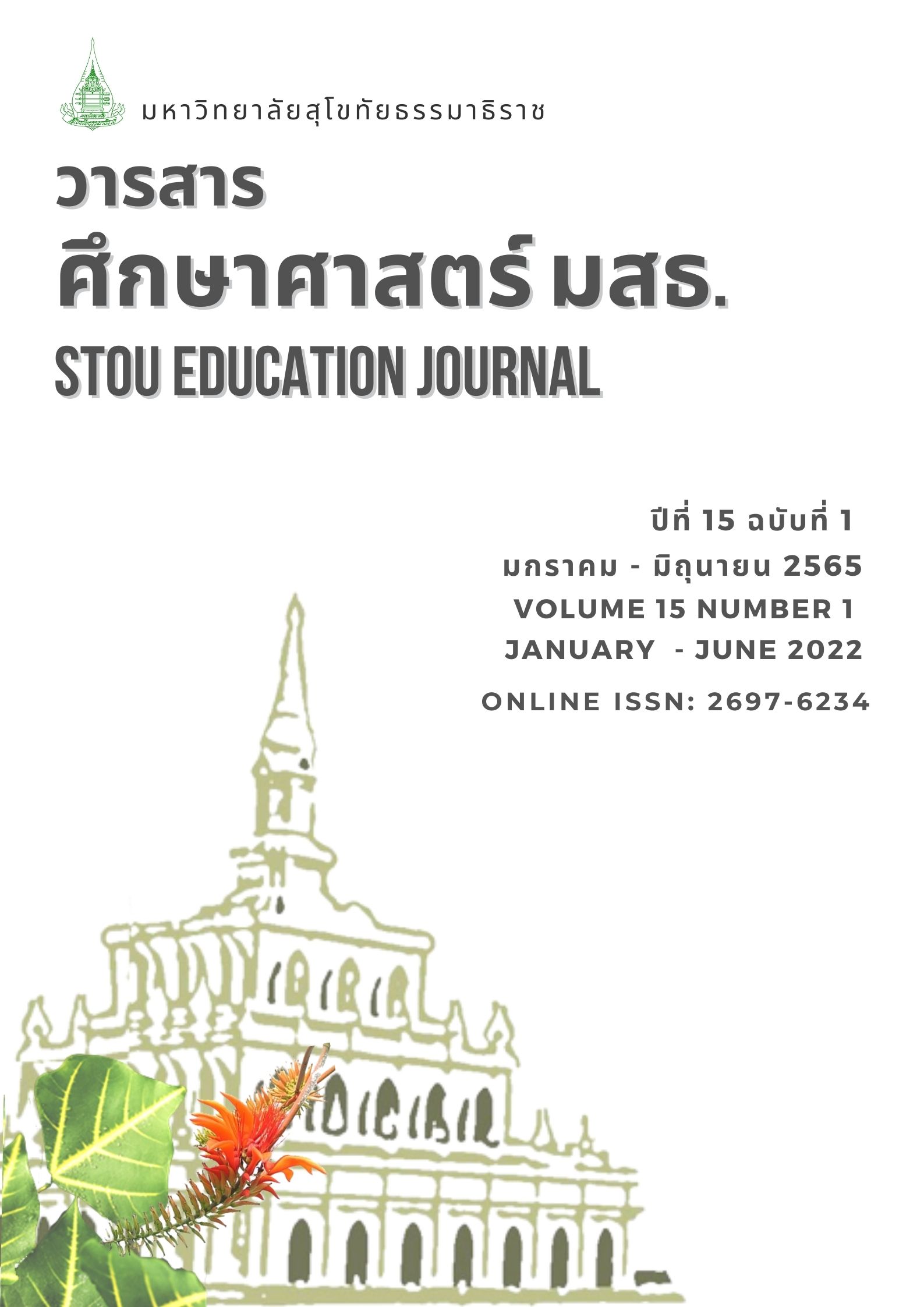Design and Development of School Readiness Enhancing Program of First Grade Students Using Design Based Research
Main Article Content
Abstract
The purposes of this research were to design, develop and study the results of implementing the school readiness enhancing program of First Grade students using the design-based research. The sample for this study consisted of 29 First Grade students and their parents, as well as two First Grade teachers. The research procedure was divided into three phases for a total of 38 weeks: phase one was the study of the users’ experience; phase two was the design of the program's principles and prototype; and phase three was the implementation of the program’s prototype. The data were collected using a school readiness evaluation form, and an evaluation form to assess the teacher's roles and the parent's roles in promoting school readiness. The data were analyzed using descriptive statistics, t-test and content analysis. The research findings indicated that (1) regarding the study of the users’ experience, it was found that the teachers and parents lacked guidelines for enhancing school readiness of First Grade students leading to the program procedure consisting of (1.1) the procedure for enhancing school readiness at school; (1.2) the procedure for enhancing school readiness at home; and (1.3) the procedure for coordinating the cooperation from parents; the three procedures were undertaken in parallel with each other covering the total of 95 hours; and (2) regarding the results of implementing the program, it was found that (2.1) all aspects of the post-implement school readiness of the students were significantly higher than all of their counterpart aspects of the pre-implement school readiness at the .05 level of statistical significance; (2.2) all post-implement roles of the teachers for enhancing the students’ school readiness were significantly higher than all of their counterpart pre-implement roles at the .05 level of statistical significance; and (2.3) all post-implement roles of the parents for enhancing the students’ school readiness were significantly higher than all of their counterpart pre-implement roles at the .05 level of statistical significance.
Article Details
References
กมลทิพย์ นิ้มคธาวุฒ. (2560). บทบาทครูในการสร้างรอยเชื่อมต่อทางการศึกษาของเด็กเพื่อเข้าสู่ชั้น ประถมศึกษาปีที่ 1. [วิทยานิพนธ์ปริญญามหาบัณฑิต ไม่ได้ตีพิมพ์].จุฬาลงกรณ์มหาวิทยาลัย.
กุณฑลี บริรักษ์สันติกุล. (2558). การพัฒนาความสามารถของครูในการออกแบบการเรียนการสอนสำหรับเด็กในระยะเชื่อมต่อ จากระดับอนุบาลสู่ระดับประถมศึกษาตามแนวคิดกลุ่มศึกษาทั้ง คณะและแนวคิดการชี้แนะทางปัญญา. [วิทยานิพนธ์ปริญญามหาบัณฑิต ไม่ได้ตีพิมพ์].จุฬาลงกรณ์มหาวิทยาลัย.
กุลชา ลี้ไพโรจน์กุล. (2555). สภาพและปัญหาการดำเนินงานของโรงเรียนในการเชื่อมต่อการศึกษา ระดับอนุบาลกับระดับประถมศึกษาปีที่ 1 ในกรุงเทพมหานคร [วิทยานิพนธ์ปริญญามหาบัณฑิต ไม่ได้ตีพิมพ์]. จุฬาลงกรณ์มหาวิทยาลัย.
จิตโสภิณ โสหา. (2560). สภาพและปัญหาของครูในการสร้างรอยเชื่อมต่อทางการศึกษาของเด็กอนุบาลเพื่อเข้าสู่ชั้นประถมศึกษา. [วิทยานิพนธ์ปริญญามหาบัณฑิต ไม่ได้ตีพิมพ์].จุฬาลงกรณ์มหาวิทยาลัย.
พัชรัตน์ ลออปักษา. (2560). บทบาทของผู้ปกครองในการสร้างรอยเชื่อมต่อทางการศึกษาจากโรงเรียนอนุบาลสู่โรงเรียนประถมศึกษา. [วิทยานิพนธ์ปริญญามหาบัณฑิต ไม่ได้ตีพิมพ์. จุฬาลงกรณ์มหาวิทยาลัย.
สถาบันแห่งชาติเพื่อการพัฒนาเด็กและครอบครัว. (2562, กรกฏาคม 15). แผนงานวิจัยการปฏิรูปสุขภาวะและการพัฒนาเด็กไทยในศตวรรษที่ 21. https://www.hsri.or.th/media/news/detail/12472
สำนักงานส่งเสริมสังคมแห่งการเรียนรู้และคุณภาพเยาวชน. (2558, มีนาคม 9). เปิดสถานการณ์เด็กปฐมวัยพบเร่งเรียนตั้งแต่วัยอนุบาล. http://www.kidsradioclub.or.th/article/treatise/134
สุวิมล ว่องวาณิช. (2559). วิธีวิทยาการวิจัยทางการศึกษา: จุดประกายความคิดใหม่. ไอคอนพริ้นติ้ง.
สุวิมล ว่องวาณิช. (2563). การวิจัยการออกแบบทางการศึกษา. สำนักพิมพ์จุฬาลงกรณ์มหาวิทยาลัย.
Bronfenbrenner, U. (1980). The ecology of human development: Experiments by nature and design. Harvard University Press.
Bronfenbrenner, U., & Morris, P. A. (1998). The bioecological model of human development handbook of child psychology: Theoretical models of human development. John Wiley & Sons Inc.
Chowa, G. A .N., & Masa, R. D. (2013). The effects of parental involvement on academic performance of Ghanaian youth, Children and Youth. Elsevier, 35(12), 2020-2030. https://www.researchgate.net/publication/259120246
Commonwealth Australia. (2017, June 27). Kids Matter Starting School information sheets for families. https://www.kidsmatter.edu.au/startingschool.
Department of Education and Training Australia. (2017, June 27). Department of Education and Training Annual Report 2017/18. https://www.dese.gov.au/about-us/resources/department-education-and-training-budget-statements-2017-18
Eldelson, D. C. (2002). Design research: What we learn when we engage in design. Journal of the Learning Sciences, 11(1), 105-121. https://www.jstor.org/stable/1466722
Epstien, J. (2001). School, family, and community partnerships: Preparing educators and improving schools (2 nd ed.). Routhledge.
National Education Goals Panel. (1997). Building a nation of learners. U.S. Government Printing Office. National Foundation for Educational.
Sink, C. A., Edwards, C. N., & Weir, S. J. (2007). Helping children transition from kindergarten to first grade. Professional School Counseling, 10(3), 233237. https://doi.org/10.5330/prsc.10.3.9l11g7633859n2w1
Unicef. (2012). School readiness: A conceptual framework. UNICEF.
Van Den Akker, J. (1999). Principles and methods of development research. In Van Akker, J., Nieveen, N., Branch, R. M., Gustsfson, K. L., & Plomp, T., (Eds.) Design methodology and developmental research in education and training. Kluwer Academic Publishers.
Wang, F., & Hannafin, M. J. (2005). Design-based research and technology-enhanced learning environments. Educational Technology Research and Development, 53(4), 5–23. https://www.researchgate.net/publication/225626676
Wanner, L.,& Sower, J. C. (2005). Educating young children from preschool through primary grades. Pearson.
Woodhead, M., & Moss, P. (2007). Early childhood and primary Education: Transitions in the lives of young children (early childhood in focus 2). The Open University.


